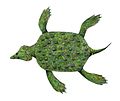| Placochelys | |
|---|---|
 | |
| Restored Placochelys placodonta skull at the Museum für Naturkunde, Berlin | |
| Scientific classification | |
| Domain: | Eukaryota |
| Kingdom: | Animalia |
| Phylum: | Chordata |
| Class: | Reptilia |
| Superorder: | † Sauropterygia |
| Order: | † Placodontia |
| Family: | † Placochelyidae |
| Genus: | † Placochelys Jaekel, 1902 |
Placochelys (from Greek : plax, plakos, "plate" and Greek : chelys, "tortoise") [1] is an extinct genus of placodont reptiles erected by Otto Jaekel in 1902.










